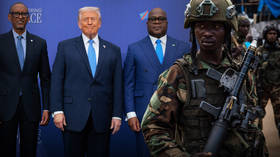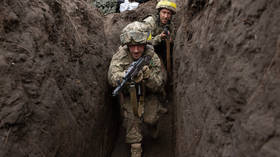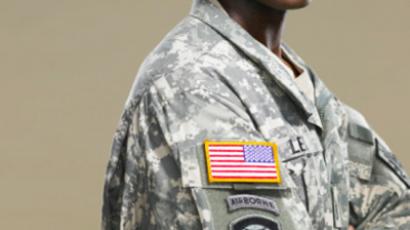Military turns down 80 percent of applicants as armed forces shrink

Gone are the post-9/11 recruiting days where the US military would take just about anyone who walked through its doors, issuing waivers for misconduct and health issues. Now 80 percent of applicants are turned away.
US Secretary of Defense Chuck Hagel announced in February of this year that the Obama administration would work to shrink the US Army to its smallest size since before World War II. Citing the federal government’s budgetary concerns and the winding down of the wars in the Middle East, Hagel deemed it necessary to reduce the military personnel and lingering, expensive equipment costs.
He said in a speech that cutting the current level of 522,000 soldiers to 490,000 soldiers by autumn of 2015 was necessary “to protect critical capabilities like Special Operations Forces and cyber resources.”
And cutting the size of the military means recruiting fewer people. The Army’s recruiting goal dropped from 69,000 new enlistments for the 2013 fiscal year to 57,000 for 2014, the US Army Recruiting Command (USAREC) reported. The Navy’s goal dropped from 40,112 in 2013 to 33,800 in 2014, according to its recruiting command.
Fewer spaces means tough choices for recruiters. “We’re turning down twice as many as before,” Army Sgt. 1st Class Terrence Hoard, who supervises the Army recruiting station in Grandview, Mo., told the Kansas City Star. Potential recruits who might have been granted waivers before are now rejected.
“It’s not that we have a zero defect mentality, because we don’t,” Nathan Christensen, a Navy officer in public affairs for the Defense Department, told the Star. “But it is true that the quality of military recruits right now is the highest it’s been in 40 years.”
Most young Americans are ineligible to join the military, either because they’re drug users, obese, medically unfit, failed to graduate high school, or have criminal records. The Pentagon estimates that only 25 percent are qualified.
"There are 30-some million 17- to 24-year-olds out there, but by the time you get all the way down to those that are qualified, you're down to less than a million young Americans," said Maj. Gen. Mark Brilakis, the commander of Marine Corps Recruiting Command, told Federal News Radio.
“Five years ago, if a kid had gotten caught with a (marijuana) joint in his car, that person would be pretty much a shoo-in” to enlist under a waiver, Hoard said to the Star. “Now you’re not authorized.”
When it comes to education, the Department of Defense considers its crop of new recruits to be ‘high quality’ if 90 percent have a high school diploma, Federal News Radio reported. Last year’s newcomers crushed that goal, with 99.6 percent having graduated.
The economy has been favorable for military enlistments since the Great Recession began in December 2007. As the economy improves, youth unemployment drops. And when fewer young people can’t find a job in the civilian sector, the military is less of a draw.
In 2013, data from the Pentagon's Joint Advertising and Market Research Studies program found that only 40 percent of the DoD's target market thought the military offered "an attractive lifestyle," down from 63 percent in 2004. The youth unemployment rate fell to 12.8 percent in April, according to the the Bureau of Labor and Statistics. The youth unemployment rate in the United States averaged 12.32 percent from 1955 until 2014, reaching an all-time high of 19.6 percent in April 2010.
"A weak economy in recent years, coupled with the talented and adequately resourced recruiting force produced the highest quality recruits in Air Force history," Brig. Gen. Gina Grosso, the director of force management policy for the Air Force, told the House Armed Services Committee in January. "However, we recognize this trend will be unsustainable as the economy continues to improve and competition to draw recruits from the small, qualified talent pool, who are alarmingly less inclined to choose military service as a career, increases dramatically."
Now the military is competing with the civilian sector for quality candidates, and they are forced to use the recruiting budgets they never needed to before - right as Congress seeks to cut those budgets.
“All this belt-tightening has caused the Department of Defense to chase after the same successful, highly motivated high school graduates that everyone else is chasing,” Mike Byrd, a retired Army lieutenant colonel and an instructor for a Junior ROTC program in Independence, Mo. told the Star.
“It’s very expensive to recruit,” he added. “We don’t have the flexibility we once had to get it wrong with one kid and hope the next one works out.”
Military recruiters are hoping Congress will continue to allot money into funding recruitment efforts and paying for expensive advertising and marketing campaigns.
“As private sector career opportunities increase, use of incentives such as enlistment bonuses will help attract recruits with the characteristics necessary for Navy service as a means of getting the right sailor with the right skills to the right place at the right time," Rear Adm. Annie Andrews, the commander of Navy Recruiting Command, told Federal News Radio.
US Military Enlistment Goals and Accessions since FY2003
(Sources: Department of Defense, Government Accountability Office)
Air Force Army Marine Corps Navy Fiscal Year
GoalActualGoalActualGoalActualGoalActual 2003 37,000 37,141
73,800 74,132 32,501 32,530 41,077 41,376 2004 34,080
34,362 77,000 77,587 36,773 36,794 39,592
39,874 2005 18,900 19,222 80,000 73,373* 32,917 32,961 37,635 37,703 2006 30,750 30,889 80,000 80,635 32,301 32,337 36,656 36,679 2007 27,801 27,801 80,000 80,407 35,576 35,603 37,000 37,361 2008 27,800 27,848 80,000 80,517 37,967 37,991 38,419 38,485 2009 31,980 31,983 65,000 70,045 31,400 31,413 35,500 35,527 2010 28,360 28,493 74,500 74,577 28,000 28,041 34,140 34,180 2011 28,515 28,518 64,000 64,019 29,750 29,773 33,400 33,444 2012 29,037 29,037 58,000 60,490 30,500 30,514 36,275 36,329 2013 26,275 26,275 69,000 69,154 32,200 32,215 40,112 40,112
*The Army was the only military to miss an enlistment goal since 2003, and only missed their goal once (in 2005).














